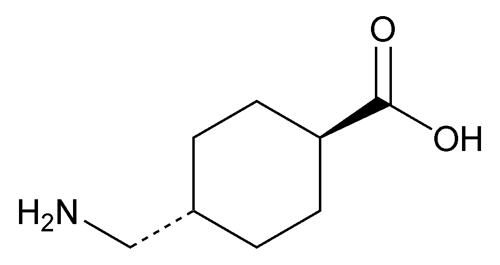Tranexamic Acid
C8H15NO2 157.2
trans-4-(Aminomethyl)cyclohexanecarboxylic acid;
Cyclohexanecarboxylic acid, 4-(aminomethyl)-, trans

 [1197-18-8].
[1197-18-8].
(tran'' ex am' ik as' id).
C8H15NO2 157.2
trans-4-(Aminomethyl)cyclohexanecarboxylic acid;
Cyclohexanecarboxylic acid, 4-(aminomethyl)-, trans
DEFINITION
Tranexamic Acid contains NLT 99.0% and NMT 101.0% of C8H15NO2, calculated on the dried basis.
IDENTIFICATION
ASSAY
• Procedure
Sample solution:
140 mg of Tranexamic Acid in 20 mL of glacial acetic acid
Titrimetric system
(See Titrimetry  541
541 .)
.)
Mode:
Direct titration
Titrant:
0.1 N perchloric acid VS
Endpoint detection:
Potentiometric
Analysis
Sample:
Sample solution
Titrate with 0.1 N perchloric acid VS, determining the endpoint potentiometrically. Carry out a blank titration.
Each mL of 0.1 N perchloric acid is equivalent to 15.72 mg of C8H15NO2.
Acceptance criteria:
99.0%–101.0% on the dried basis
IMPURITIES
Inorganic Impurities
• Residue on Ignition  281
281 :
NMT 0.1%; 1-g sample is used
:
NMT 0.1%; 1-g sample is used
• Heavy Metals, Method II  231
231 :
NMT 10 ppm
:
NMT 10 ppm
• Chloride and Sulfate, Chloride  221
221 :
A 0.51-g portion shows no more chloride than corresponds to 0.1 mL of 0.020 N hydrochloric acid (0.014%).
:
A 0.51-g portion shows no more chloride than corresponds to 0.1 mL of 0.020 N hydrochloric acid (0.014%).
Organic Impurities
• Procedure
Mobile phase:
Dissolve 11.0 g of anhydrous monobasic sodium phosphate in 500 mL of water, and add 5 mL of triethylamine, followed by 1.4 g of sodium lauryl sulfate. Adjust with diluted phosphoric acid (10% w/w) to a pH of 2.5, and dilute with water to 600 mL. Mix this solution with 400 mL of methanol.
System suitability solution:
0.2 mg/mL of USP Tranexamic Acid RS and 0.002 mg/mL of USP Tranexamic Acid Related Compound C RS in water
Standard solution:
50 µg/mL of USP Tranexamic Acid RS in water
Sample solution:
10 mg/mL of Tranexamic Acid in water
Chromatographic system
Mode:
LC
Detector:
UV 220 nm
Column:
4.6-mm × 25-cm; 5-µm packing L1
Flow rate:
1 mL/min
Injection size:
20 µL
Run time:
3 times the retention time of tranexamic acid
System suitability
Sample:
System suitability solution
Suitability requirements
Resolution:
NLT 2.0 between tranexamic acid and 0.002 mg/mL of tranexamic acid related compound C
Analysis
Samples:
Standard solution and Sample solution
Calculate the percentage of each individual impurity in the portion of Tranexamic Acid taken:
Result = (rU/rS) × (CS/CU) × (0.1F)
| rU | = | = peak response for each impurity from the Sample solution |
| rS | = | = peak response for tranexamic acid from the Standard solution |
| CS | = | = concentration of USP Tranexamic Acid RS in the Standard solution (µg/mL) |
| CU | = | = concentration of Tranexamic Acid in the Sample solution (mg/mL) |
| F | = | = relative response factor (see Impurity Table 1) |
Acceptance criteria
Individual impurities:
See Impurity Table 1.
Total impurities:
NMT 0.2%
[Note—Disregard any peak less than 0.025%. ]
Impurity Table 1
| Name | Relative Retention Time |
Relative Response Factor |
Acceptance Criteria, NMT (%) |
|---|---|---|---|
| Tranexamic acid related compound Aa | 2.1 | 1 | 0.1 |
| Tranexamic acid related compound Bb | 1.5 | 1.2 | 0.2 |
| Tranexamic acid related compound Cc | 1.1 | 0.005 | 0.1 |
| Tranexamic Acid | 1.0 | 1.0 | — |
| Tranexamic acid related compound Dd | 1.3 | 0.006 | 0.1 |
|
a
trans,trans-4,4¢-(Iminodimethylene)di(cyclohexanecarboxylic)acid.
b
cis-4-(Aminomethyl)cyclohexanecarboxylic acid.
c
(RS)-4-(Aminomethyl) cyclohex-1-enecarbocylic acid.
d
4-Aminomethyl benzoic acid.
|
|||
SPECIFIC TESTS
• Loss on Drying  731
731 :
Dry 1.00 g at 105
:
Dry 1.00 g at 105 under vacuum for 2 h. It loses NMT 0.5% of its weight.
under vacuum for 2 h. It loses NMT 0.5% of its weight.
ADDITIONAL REQUIREMENTS
• Packaging and Storage:
Preserve in tight containers, and store at a temperature not exceeding 30 .
.
• USP Reference Standards  11
11
USP Tranexamic Acid Related Compound C RS
(RS)-4-(Aminomethyl)cyclohex-1-enecarbocylic acid.
C8H13NO2 155
(RS)-4-(Aminomethyl)cyclohex-1-enecarbocylic acid.
C8H13NO2 155
Auxiliary Information—
Please check for your question in the FAQs before contacting USP.
| Topic/Question | Contact | Expert Committee |
|---|---|---|
| Monograph | Sujatha Ramakrishna, Ph.D.
Senior Scientific Liaison 1-301-816-8349 |
(SM22010) Monographs - Small Molecules 2 |
| Reference Standards | RS Technical Services 1-301-816-8129 rstech@usp.org |
USP35–NF30 Page 4911
Pharmacopeial Forum: Volume No. 34(6) Page 1484

